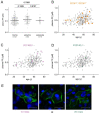Plasma Level of Pyrophosphate Is Low in Pseudoxanthoma Elasticum Owing to Mutations in the ABCC6 Gene, but It Does Not Correlate with ABCC6 Genotype
- PMID: 36769695
- PMCID: PMC9917606
- DOI: 10.3390/jcm12031047
Plasma Level of Pyrophosphate Is Low in Pseudoxanthoma Elasticum Owing to Mutations in the ABCC6 Gene, but It Does Not Correlate with ABCC6 Genotype
Abstract
Background: Pseudoxanthoma elasticum (PXE), a monogenic disorder resulting in calcification affecting the skin, eyes and peripheral arteries, is caused by mutations in the ABCC6 gene, and is associated with low plasma inorganic pyrophosphate (PPi). It is unknown how ABCC6 genotype affects plasma PPi.
Methods: We studied the association of ABCC6 genotype (192 patients with biallelic pathogenic ABCC6 mutations) and PPi levels, and its association with the severity of arterial and ophthalmological phenotypes. ABCC6 variants were classified as truncating or non-truncating, and three groups of the 192 patients were formed: those with truncating mutations on both chromosomes (n = 121), those with two non-truncating mutations (n = 10), and a group who had one truncating and one non-truncating ABCC6 mutation (n = 61). The hypothesis formulated before this study was that there was a negative association between PPi level and disease severity.
Results: Our findings confirm low PPi in PXE compared with healthy controls (0.53 ± 0.15 vs. 1.13 ± 0.29 µM, p < 0.01). The PPi of patients correlated with increasing age (β: 0.05 µM, 95% CI: 0.03-0.06 per 10 years) and was higher in females (0.55 ± 0.17 vs. 0.51 ± 0.13 µM in males, p = 0.03). However, no association between PPi and PXE phenotypes was found. When adjusted for age and sex, no association between PPi and ABCC6 genotype was found.
Conclusions: Our data suggest that the relationship between ABCC6 mutations and reduced plasma PPi may not be as direct as previously thought. PPi levels varied widely, even in patients with the same ABCC6 mutations, further suggesting a lack of direct correlation between them, even though the ABCC6 protein-mediated pathway is responsible for ~60% of this metabolite in the circulation. We discuss potential factors that may perturb the expected associations between ABCC6 genotype and PPi and between PPi and disease severity. Our findings support the argument that predictions of pathogenicity made on the basis of mutations (or on the structure of the mutated protein) could be misleading.
Keywords: PXE; ectopic mineralization; genotype-phenotype association; plasma pyrophosphate; pseudoxanthoma elasticum.
Conflict of interest statement
AV is co-inventor on patent applications related to the use of pyrophosphates for therapeutic applications. Application NL20117471, entitled ‘Oral Pyrophosphate For Use In Reducing Tissue Calcification’, is continued as US 16/333,856 and EP17781568.5. Two subsequent patent applications have been filed for improved pyrophosphate salts which improve tolerability and bioavailability: NL2023491 and US 63/091,467, and AV is owner of shares in Pyrogenyx Inc. The other authors declare no conflict of interest.
Figures




References
-
- Jansen R.S., Duijst S., Mahakena S., Sommer D., Szeri F., Váradi A., Plomp A., Bergen A.A., Oude Elferink R.P.J., Borst P., et al. ABCC6-Mediated ATP Secretion by the Liver Is the Main Source of the Mineralization Inhibitor Inorganic Pyrophosphate in the Systemic Circulation-Brief Report. Arterioscler. Thromb. Vasc. Biol. 2014;34:1985–1989. doi: 10.1161/ATVBAHA.114.304017. - DOI - PMC - PubMed
Grants and funding
- OTKA 127957/National Research, Development and Innovation Office of Hungary
- OTKA 127933/National Research, Development and Innovation Office of Hungary
- PD-OTKA 128003/National Research, Development and Innovation Office of Hungary
- PD-OTKA 123859/National Research, Development and Innovation Office of Hungary
LinkOut - more resources
Full Text Sources
Miscellaneous

